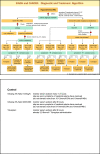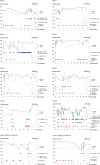A rapid and efficient way to manage hyponatremia in patients with SIADH and small cell lung cancer: treatment with tolvaptan - PubMed (original) (raw)
Clinical Trial
A rapid and efficient way to manage hyponatremia in patients with SIADH and small cell lung cancer: treatment with tolvaptan
Claudia Petereit et al. BMC Pulm Med. 2013.
Abstract
Background: Hyponatremia based on syndrome of inappropriate antidiuretic hormone hypersecretion (SIADH) is observed in up to 15% of patients with small cell lung cancer (SCLC). The electrolyte imbalance is associated with a high morbidity and mortality and often delays appropriate treatment. Management of hyponatremia proved to be challenging until new vasopressin-2 receptor antagonists such as tolvaptan became available. This is the first report which presents a prospective case series with an efficient management of hyponatremia including tolvaptan in ten patients with SCLC and severe SIADH (plasma sodium < 125 mmol/l).
Methods: Ten patients with SCLC and severe SIADH were followed after the onset of clinical symptoms of SIADH. Patients were chosen on the basis of histological proven diagnosis of SCLC and the clinical picture of a neurocognitive deficit caused by SIADH-related hyponatremia. All patient data were monitored for clinical improvement based on ECOG status, commencement of chemotherapy and correction of sodium levels.
Results: The treatment followed a diagnostic and treatment algorithm and lead to a rapid and efficient correction of both clinical symptoms and plasma sodium level.
Conclusions: Based on this algorithm all patients started chemotherapy in time. Subsequently, the treatment with tolvaptan lead to an improvement of the ECOG-performance status. In addition, all patients benefit from the effective management of SIADH which omitted prolonged hospital stays and non-elective hospitalizations due to an unstable clinical condition due to severe hyponatremia. These observations add new insight to management of SIADH in thoracic oncology and are of interest for specialists in oncology, endocrinology and pulmonary medicine.
Figures
Figure 1
Diagnostic and treatment algorithm.
Figure 2
Diagrams for the cases one to ten with the clinical course (sodium levels, applied chemotherapy, ECOG performance status).
Similar articles
- Efficacy and safety of long-term tolvaptan treatment in a patient with SCLC and SIADH.
Bordi P, Tiseo M, Buti S, Regolisti G, Ardizzoni A. Bordi P, et al. Tumori. 2015 Apr 28;101(2):e51-3. doi: 10.5301/tj.5000249. Tumori. 2015. PMID: 25702667 - Tolvaptan use in cancer patients with hyponatremia due to the syndrome of inappropriate antidiuretic hormone: a post hoc analysis of the SALT-1 and SALT-2 trials.
Gralla RJ, Ahmad F, Blais JD, Chiodo J 3rd, Zhou W, Glaser LA, Czerwiec FS. Gralla RJ, et al. Cancer Med. 2017 Apr;6(4):723-729. doi: 10.1002/cam4.805. Epub 2017 Mar 2. Cancer Med. 2017. PMID: 28251822 Free PMC article. Clinical Trial. - Case report: Secondary failure to tolvaptan in a patient with SCLC and paraneoplastic SIADH.
Menzi S, Jaramillo SD, Pfister S, Schefer H, Jehle AW. Menzi S, et al. Front Endocrinol (Lausanne). 2024 May 13;15:1382066. doi: 10.3389/fendo.2024.1382066. eCollection 2024. Front Endocrinol (Lausanne). 2024. PMID: 38803472 Free PMC article. - Diagnosis and management of hyponatremia in cancer patients.
Castillo JJ, Vincent M, Justice E. Castillo JJ, et al. Oncologist. 2012;17(6):756-65. doi: 10.1634/theoncologist.2011-0400. Epub 2012 May 22. Oncologist. 2012. PMID: 22618570 Free PMC article. Review. - [Treatment of hyponatremia: role of vaptans].
Hensen J. Hensen J. Internist (Berl). 2010 Dec;51(12):1499-509. doi: 10.1007/s00108-010-2717-z. Internist (Berl). 2010. PMID: 21104220 Review. German.
Cited by
- A Clinical Analysis of Anti-Programmed Death-Ligand 1 (PD-L1) Immune Checkpoint Inhibitor Treatments Combined with Chemotherapy in Untreated Extensive-Stage Small-Cell Lung Cancer.
Hsu PC, Wu BC, Wang CC, Chiu LC, Chang CH, Liu PC, Wu CE, Kuo SC, Ju JS, Huang AC, Lin YC, Yang CT, Ko HW. Hsu PC, et al. Vaccines (Basel). 2024 Apr 29;12(5):474. doi: 10.3390/vaccines12050474. Vaccines (Basel). 2024. PMID: 38793725 Free PMC article. - Paraneoplastic Syndromes in Neuroendocrine Prostate Cancer: A Systematic Review.
Abufaraj M, Ramadan R, Alkhatib A. Abufaraj M, et al. Curr Oncol. 2024 Mar 21;31(3):1618-1632. doi: 10.3390/curroncol31030123. Curr Oncol. 2024. PMID: 38534956 Free PMC article. Review. - Symptomatic syndrome of inappropriate anti-diuretic hormone as a rare early presentation of primary thymic carcinoma: a case report.
Samsuddin MJ, Yaacob SS, Razi AABM. Samsuddin MJ, et al. J Surg Case Rep. 2024 Feb 9;2024(2):rjae025. doi: 10.1093/jscr/rjae025. eCollection 2024 Feb. J Surg Case Rep. 2024. PMID: 38344137 Free PMC article. - Hyponatraemia and the syndrome of inappropriate antidiuresis (SIAD) in cancer.
Donald DM, Sherlock M, Thompson CJ. Donald DM, et al. Endocr Oncol. 2022 Jul 11;2(1):R78-R89. doi: 10.1530/EO-22-0056. eCollection 2022 Jan. Endocr Oncol. 2022. PMID: 37435459 Free PMC article. Review. - Psychiatric disorders associated with immune checkpoint inhibitors: a pharmacovigilance analysis of the FDA Adverse Event Reporting System (FAERS) database.
Zhou C, Peng S, Lin A, Jiang A, Peng Y, Gu T, Liu Z, Cheng Q, Zhang J, Luo P. Zhou C, et al. EClinicalMedicine. 2023 Apr 21;59:101967. doi: 10.1016/j.eclinm.2023.101967. eCollection 2023 May. EClinicalMedicine. 2023. PMID: 37131541 Free PMC article.
References
- Kalemkerian GP, Akerley W, Bogner P, Borghaei H, Chow L, Downey RJ, Gandhi L, Ganti AK, Govindan R, Grecula JC, Hayman J, Heist RS, Horn L, Jahan TM, Koczywas M, Moran CA, Niell HB, O’Malley J, Patel JD, Ready N, Rudin CM, Williams CC Jr. Small cell lung cancer. National Comprehensive Cancer Network. 2011;10:1086–113. - PubMed
- Petereit C, Zaba O, Teber I, Grohé C. Is hyponatremia a prognostic marker of survival for lung cancer? Pneumologie. 2011;65(9):565–71. - PubMed
Publication types
MeSH terms
Substances
LinkOut - more resources
Full Text Sources
Other Literature Sources
Medical

